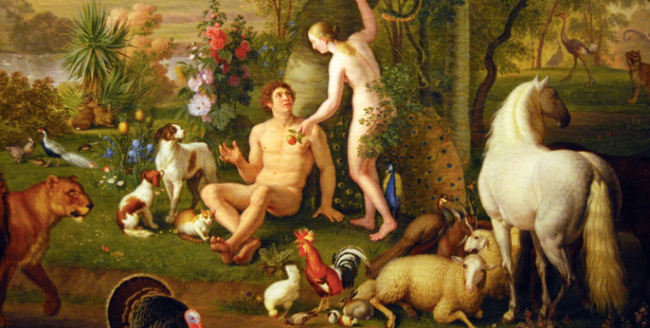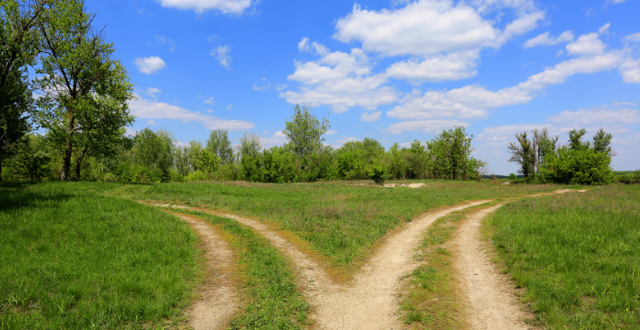Worship services on Christmas Eve and Christmas Day tell the story of Jesus’ birth from the two gospels that include it—Luke and Matthew. Churches reenact the story, and many children’s books conclude the telling by depicting the sleeping savior surrounded by reverent people and curious animals.
I have always found these stories, and the imaginative ways we depict them, beautiful, compelling, and comforting. But I have also wondered about the significance of one particular detail. We hear the angels tell the shepherds, “Today in the town of David a Savior has been born to you; he is the Messiah, the Lord.” But then they say, “This will be a sign to you: You will find a baby wrapped in cloths and lying in a manger.” (Luke 2:11-12). What does it mean for the Savior to be lying in a feed trough for animals? Could there be something about this detail that invites us to consider Jesus in a new light?

Back to the Beginning
In Genesis 2, God creates Adam, places him in the Garden of Eden, and decides that Adam needs a helper. God’s first attempt is to bring all the wild animals and birds to Adam. Think about this for a moment; the animals are formed out of the same ground as Adam, and there is an assumption that intimate relationship between Adam and the animals is not only possible but intended. In others words, Adam and the other creatures are deeply connected – they are kin.
The disruption of relationships caused by human disobedience includes relationships between humans and animals, and there are different perspectives in the Old Testament about how to deal with the reality that we are not at peace with animals.

The OT and Wild Animals – Two Paths to Consider
There are many Old Testament texts that imagine what will happen when God shows up to set things right and establish a new era of peace. This includes consideration of wild animals, which were generally seen as threats to human safety. Ezekiel 34:25 is representative of a way of imagining a future in which the threat from wild animals is solved by their removal.
I will make with [Israel] a covenant of peace and banish wild animals from the land, so that they may live in the wild and sleep in the woods securely.
The idea here is that the people of Israel could live in the forest again, like Adam. The wild animals are not killed, just driven off, because living in harmony is not seen as possible.
This contrasts with visions of the future in which a more comprehensive shalom is possible. Isaiah 11:6-9 is representative of this perspective.
The wolf shall live with the lamb,
the leopard shall lie down with the kid,
the calf and the lion and the fatling together,
and a little child shall lead them.
The cow and the bear shall graze,
their young shall lie down together;
and the lion shall eat straw like the ox.
The nursing child shall play over the hole of the asp,
and the weaned child shall put its hand on the adder’s den.
In this vision, the danger posed by wild animals has been removed. It even imagines vegetarian lions! So, you may wonder, what does this have to do with Jesus?
Jesus in the Wilderness
There is a provocative little detail in Mark’s short description of Jesus’ temptation that is easy to overlook.
The Spirit sent him out in the wilderness, and he was in the wilderness forty days, being tempted by Satan. He was with the wild animals, and angels attended him” (Mark 1:12-13).
Jesus’ time in the wilderness prepares him for the launch of his saving mission to humanity. What we often miss is that part of this preparation is establishing his relationship as the Messiah to the non-human creation. The first relationship is with Satan, whom he resists as a clear enemy. The third relationship is with the angels, whom he welcomes as friends. In between are the wild animals; Mark’s spare narrative tells us that Jesus was simply with them. Jesus does not see them as enemies to be resisted, domesticated or banished. But they are also not like the angels, who are there to serve Jesus. What we see in this brief account is Jesus demonstrating what God’s peace looks like with these wild creatures. He lets them be who they were created to be, and is simply with them in friendship and peace. Jesus is clearly aligned with Isaiah’s vision more than Ezekiel’s!
This suggests three things for us to reflect on.
1) Jesus Is Not Just For Us
The baby that was laid in the manger is the savior of the world, not just humanity. We see in his time with the wild animals in the wilderness a reminder of Eden and a vision for the future. We also see that his life, death, and resurrection will have implications for our fellow creatures, even if it is hard to imagine what those might be (vegetarian lions?). What is clear is that we must acknowledge and celebrate Jesus as the lord of creation, not just humanity. And, just like every other aspect of our theological understanding, this has ethical implications.
2) Wild Animals Have a Place In God’s World
We should not miss the irony that the threat of wild animals to humans reflected in Scripture is now overshadowed by the threat to wild animals by humans. We are in the midst of the planet’s sixth extinction event, and it is largely caused by us. We kill, resist, domesticate, and banish wild creatures at a rate never seen before. This is not to say that wild animals do not still threaten human beings, just that the conflict is decidedly one-sided. For instance, sharks kill approximately 10 humans each year; we kill more than 70,000,000 sharks each year. The diminishing diversity of creatures, which is clearly anti-Eden and anti-Jesus, should sadden us and galvanize us to seek a different way.
3)We Must Learn to Live In Peace With Our Fellow Creatures
The fact that figuring out how to live in peace with our fellow creatures is a difficult task should not dissuade us from trying. Here are some ideas to consider:
- Learn about the wild creatures in your region and how you might care for them.
- Spend time in wild places, even if it is only your backyard or the local park.
- Do not kill, domesticate or banish other creatures without clear cause.
- If you hunt or eat meat, do so as ethically as possible.
- Cultivate love for other creatures, to see them as Jesus does.
If you have other ideas, please share them with other readers in the comments, or email me directly at james.amadon@circlewood.online.
When we celebrate Christmas and look upon the baby in the manger with hope, we can also look for ways to make that hope reality with the wild kin that share our world.
With you on the Way,
James